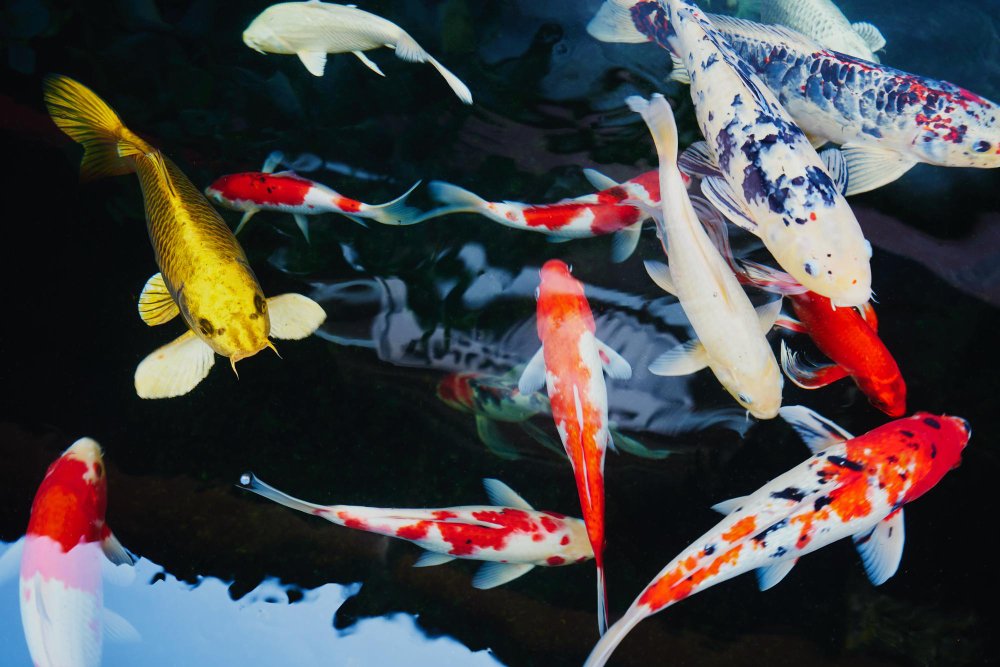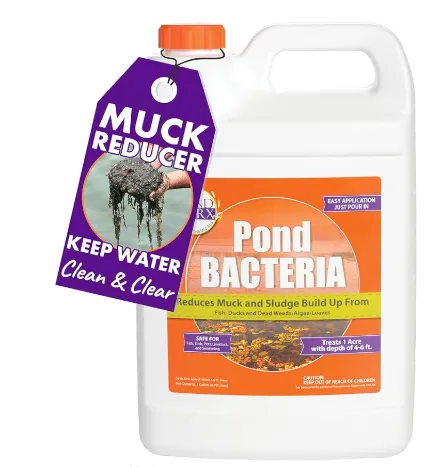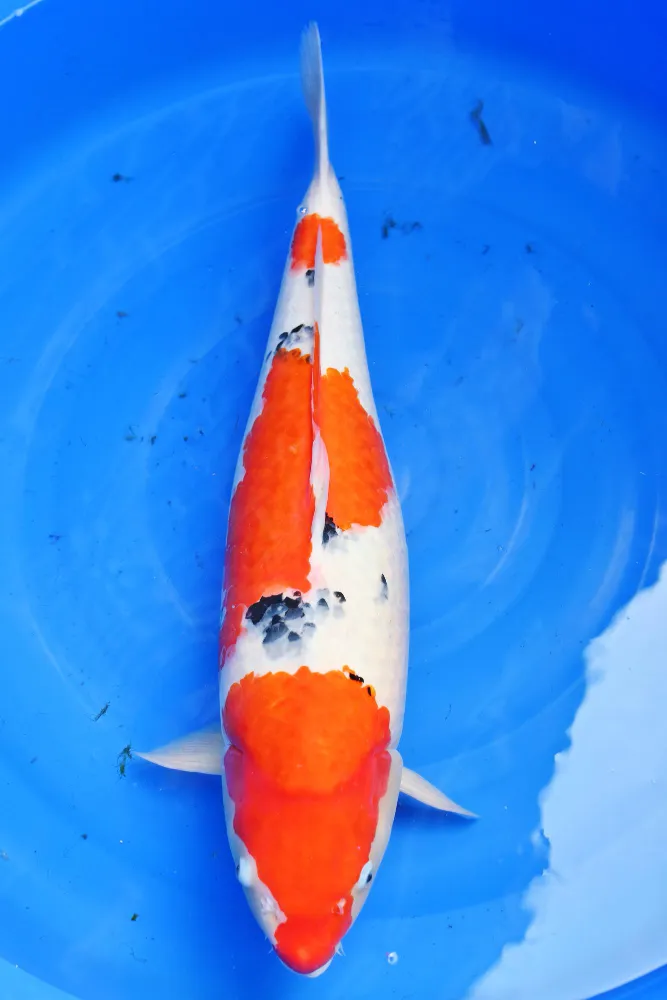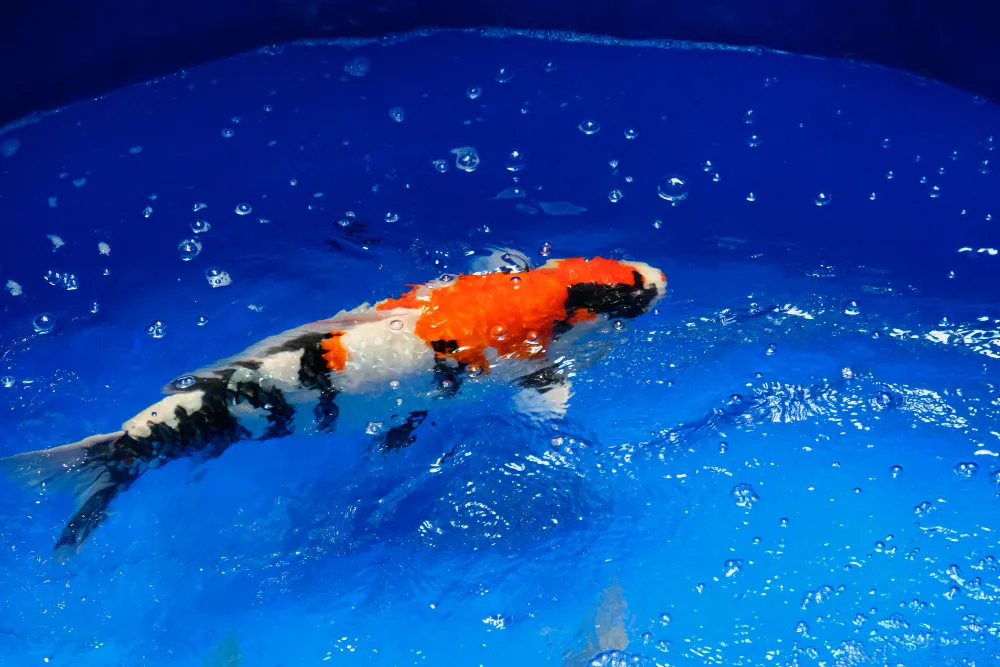

Introduction to Koi Fish Characteristics of Koi Fish
Characteristics of Koi Fish, Koi fish, known scientifically as Cyprinus rubrofuscus, have captivated aquarists and pond enthusiasts worldwide with their striking beauty and tranquil presence. Originating from Japan and representing a cultural symbol of luck, prosperity, and perseverance, Koi have transcended their humble beginnings as ordinary carp to become prized ornamental fish. Their vibrant colors, intricate patterns, and serene demeanor make them a popular choice for garden ponds and water features.
In this article, we will explore the fascinating characteristics of Koi fish, including their color variations, size and growth potential, and the pond requirements necessary for their care. Whether you are considering adding Koi to your pond or simply wish to learn more about these exquisite creatures, this comprehensive guide offers valuable insights for every pet owner.
Color Variations Characteristics of Koi Fish

Understanding Koi Color Patterns Characteristics of Koi Fish
The allure of Koi fish lies significantly in their diverse color patterns. Each color variation has a specific designation, reflecting the unique markings and shades that define Koi aesthetics. The primary colors found in Koi include red, white, black, yellow, and blue, each capable of manifesting in various combinations and intensities. Understanding these patterns is essential for Koi enthusiasts, as each one contributes to the overall beauty and value of the fish.
Common patterns include the Kohaku (white with red markings), Taisho Sanshoku (white with red and black markings), and Showa Sanshoku (black with red and white markings). The interplay of color and pattern can influence a Koi’s desirability and price, making these features a critical consideration for breeders and hobbyists alike.

Common Color Varieties Characteristics of Koi Fish
Among the plethora of Koi color varieties, some have gained immense popularity due to their striking appearances. For instance, the Sanke Koi boasts a white body decorated with red and black patches, while the Asagi features a blue-gray body with red markings along the sides. The Shiro Utsuri, characterized by its stark black and white patterns, commands attention for its dramatic contrast. Each Koi variety offers unique aesthetic appeal, allowing enthusiasts to create stunning visual displays in their ponds.
Other notable color varieties include the Gin Rin (sparkling scales), which can come in various colors, and the Matsuba, which typically has a solid color with a net-like pattern of scales. The broad range of options available ensures that every Koi owner can find fish that resonate with their personal aesthetic and the overall design of their water feature.
Significance of Color in Koi Characteristics of Koi Fish
Beyond their visual appeal, the colors of Koi fish carry cultural significance, particularly in Japanese tradition. Certain colors are believed to symbolize good fortune and prosperity. For example, red is often associated with strength and vitality, while white signifies purity and cleanliness. The combination of these colors in a Koi can resonate deeply with their owners, reflecting personal beliefs or aspirations.
Moreover, the color of a Koi can change over time, particularly as they mature. Factors such as diet, water quality, and environmental conditions can influence color intensity and pattern clarity. As Koi owners observe these transformations, they gain a deeper appreciation for the dynamic nature of these fish, which adds to the joy of keeping them in captivity.

Size and Growth Characteristics of Koi Fish
Typical Sizes of Koi Fish
Koi fish are renowned not only for their beauty but also for their potential size. When maintained in optimal conditions, Koi can grow impressively large, with some varieties reaching lengths of up to 36 inches or more. On average, most Koi will measure between 24 to 30 inches when fully grown, making them significant inhabitants of any pond. Their growth potential can be a draw for pond owners who appreciate the impressive visual impact of larger fish.
The growth rate of Koi fish can vary significantly depending on several factors, including genetics, environmental conditions, and care practices. While younger Koi may grow rapidly during their initial years, their growth often slows as they approach maturity. Understanding this growth pattern can assist owners in managing their expectations and creating the ideal environment for their Koi to thrive.
Factors Affecting Growth Rates Characteristics of Koi Fish
Several key factors influence the growth rates of Koi fish. Water temperature plays a crucial role; Koi are cold-blooded animals, and their metabolism is directly affected by water conditions. Warmer water temperatures can enhance growth rates, while colder temperatures can slow their development. Therefore, maintaining a stable, warm environment is essential for optimal growth.
Nutrition is another critical element influencing Koi growth. A balanced diet rich in proteins, vitamins, and minerals is vital for healthy development. High-quality Koi food formulated for growth can significantly impact the rate at which Koi reach their full size. Additionally, the pond’s overall health, including water quality and the presence of adequate space for swimming and foraging, contributes to their growth potential.
Caring for Growing Koi Characteristics of Koi Fish
To promote healthy growth in Koi fish, owners should focus on providing suitable living conditions. A well-maintained pond with sufficient depth and surface area allows Koi to swim freely and develop muscle strength. Moreover, incorporating plants and hiding spots can create a more natural and stimulating environment, reducing stress and encouraging healthy growth.
Regular monitoring of water parameters, including pH, ammonia, nitrite, and nitrate levels, is essential for maintaining a safe habitat. Additionally, performing routine water changes can help ensure that Koi have access to clean, oxygen-rich water, further enhancing their growth and overall health. Making these considerations a priority will lead to happier, healthier Koi that flourish in their aquatic home.

Pond Requirements Characteristics of Koi Fish
Ideal Pond Conditions for Koi
Establishing an ideal pond environment is paramount for the well-being of Koi fish. The pond should ideally have a minimum depth of 3 to 4 feet to protect Koi from temperature fluctuations and predators. Deeper areas allow Koi to retreat during hotter months, while shallow areas can provide warmth in the cooler months. Additionally, providing ample surface area is critical, as Koi require space for swimming, social interactions, and feeding.
Creating varied depths and structures within the pond can enhance the habitat for Koi. Implementing features such as rock formations, plants, and waterfalls can contribute to a more enriching environment. These elements not only offer hiding places and breeding grounds but also facilitate the natural filtration process, leading to improved water quality.
Water Quality and Maintenance
Water quality is one of the most crucial factors affecting the health of Koi fish. Monitoring and maintaining optimal water conditions is essential for preventing diseases and promoting growth. Koi thrive in water with a pH level between 7.0 and 8.0, and maintaining adequate levels of dissolved oxygen is equally important. Owners should regularly test water parameters and make adjustments as necessary to ensure a safe environment.
Implementing a robust filtration system can significantly enhance water quality by removing debris and harmful substances. Regular water changes, alongside the use of beneficial bacteria to promote a healthy ecosystem, are also essential maintenance practices. Owners should aim to change approximately 10-20% of the pond water weekly to maintain optimal conditions for their Koi.
Space and Habitat Needs
In addition to water quality, the physical space and habitat design of the pond play a significant role in Koi health and happiness. Koi fish are social creatures, and they thrive in groups. Therefore, providing enough swimming space for a group of Koi is essential; a general guideline is to allow at least 1,000 gallons of water for every three to four adult Koi. This ensures that the fish have adequate room to swim freely without overcrowding, which can lead to stress and aggression.
Incorporating aquatic plants into the pond design can also enhance Koi habitats. Not only do plants provide shade and shelter, but they also help improve water quality by absorbing excess nutrients and providing oxygen. Floating plants, submerged plants, and marginal plants all contribute to a balanced ecosystem, promoting the overall health of the Koi and the pond environment.
Conclusion Characteristics of Koi Fish
Koi fish represent a unique blend of natural beauty and cultural significance, making them cherished inhabitants of garden ponds worldwide. Understanding their color variations, growth potential, and habitat requirements is essential for any prospective Koi owner. By providing ideal conditions and proper care, Koi can thrive, bringing joy and tranquility to any outdoor space.
As a passionate pet owner, investing time and effort into creating a suitable environment for Koi can result in a rewarding and enriching experience. Observing the graceful movements, vibrant colors, and sociable nature of Koi is not just a pastime but a deep connection to nature that enhances the enjoyment of outdoor living spaces.
FAQs Characteristics of Koi Fish
How long do Koi fish typically live?
Koi fish can live for several decades, with many reaching ages of 20 to 30 years. Some exceptional specimens have been known to live over 200 years under ideal conditions.
What should I feed my Koi fish?
Koi should be fed a balanced diet consisting of high-quality Koi pellets, supplemented with fresh vegetables, fruits, and occasional treats like insects. It’s important to adjust the diet based on the season and water temperature.
How do I prevent diseases in Koi fish?
To prevent diseases, maintain optimal water quality, feed a balanced diet, and monitor Koi for any signs of illness. Regular pond maintenance, including cleaning and water changes, is also crucial.
Can Koi be kept with other fish?
Koi can be kept with other fish species, but it is essential to choose compatible species that can thrive in the same conditions and avoid those that may outcompete Koi for food or become aggressive.
What size pond is best for Koi?
The best pond size for Koi should have a minimum depth of 3 to 4 feet and at least 1,000 gallons of water for every three to four adult fish to provide adequate space and habitat for their growth and health.
You may also like
- https://giobelkoicenter.com/serene-koi-pond/
- https://giobelkoicenter.com/how-long-do-koi-fish-live/
- https://giobelkoicenter.com/finding-the-best-petsmart-near-you/
- https://giobelkoicenter.com/how-fast-do-koi-fry-grow/
- https://giobelkoicenter.com/koi-pond-phone-case/
- https://giobelkoicenter.com/butterfly-koi-lifespan/
Table of Contents
Passionate about fish keeping since elementary school in the 1980s, Giovanni Carlo has dedicated countless hours to collecting and breeding a diverse array of ornamental freshwater fish. From vibrant guppies and majestic koi to striking bettas and classic goldfish, he continues to explore the fascinating world of aquatics, sharing knowledge and enthusiasm with fellow fish enthusiasts.